Spectrum: Autism Research News
The treasures of monkey island
On Cayo Santiago island, scientists track the alliances and power struggles of a colony of feral monkeys — collecting data to generate new insights into the social challenges that people with autism face.
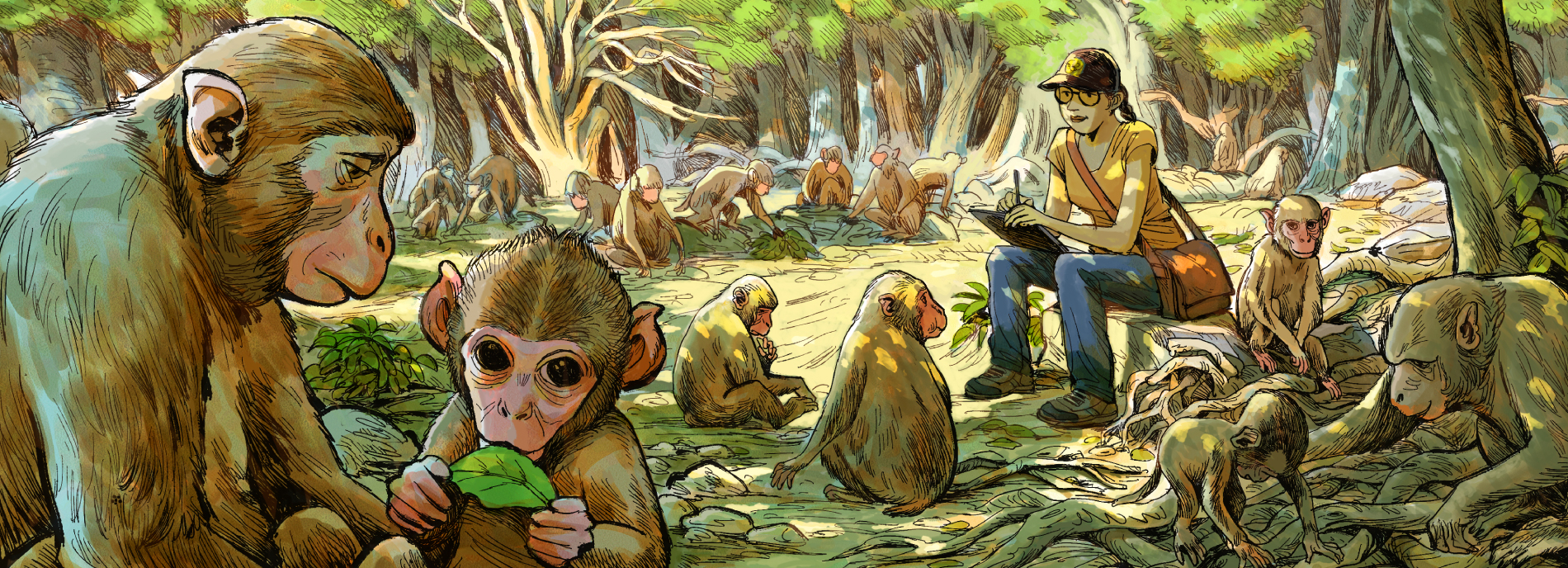
41N sits alone under the waxy leaves of a bay rum tree. When he hears us approaching, he looks up from the ground and smacks his lips as though he has peanut butter on the roof of his mouth. The gray hair on his chest hides his identifying tattoo, but this 16-year-old rhesus macaque is hard to mistake: He has freckles on his face and smears of red extending horizontally from his eyes like war paint. Because March is the breeding season here on Cayo Santiago — Puerto Rico’s so-called ‘Monkey Island’ — his face and genitals are tinted a garish coral hue.
For Michael Platt, a neuroscientist who is normally stuck in his lab at the University of Pennsylvania in Philadelphia, this moment was the first time he was able to match a face to a gene. 41N is one of 40 macaques on Cayo Santiago that Platt’s group identified last year as carrying a naturally occurring variant of a gene called SHANK3. This gene codes for a protein that strengthens the connections between neurons. About 1 percent of people with autism have a mutation in SHANK3; on Cayo Santiago, potentially one out of every eight monkeys possesses this SHANK3 variant. As in people, a disruption of this gene affects the monkeys’ social lives. “Are those autistic monkeys?” Platt says, immediately answering his own question with a scientist’s allergy to hype: “I don’t know.”
What makes Cayo Santiago special is that it is a haven for social diversity. Most traditional research colonies would have weeded out uncooperative monkeys or ones with behavioral issues, but the monkeys here are left to themselves. The island was first stocked with macaques from India for medical research in the late 1930s, and now has more than 1,500 crammed into an area the size of around eight city blocks. The primate population density here rivals that of the New York City metropolitan area. The monkeys, slightly larger than house cats, make friends, raise families and mourn the loss of their loved ones. They have formed six tightly knit groups, and within those groups there are defined pecking orders. The social butterflies, for instance, spend time with other social butterflies — forming a popular in-group.
41N and his ilk are neither more nor less gregarious than run-of-the-mill macaques. Rather, they are more adventurous when it comes to picking their friends. Instead of joining a pre-existing social clique, they form relationships with monkeys that don’t necessarily spend time with one another, creating a bridge between cliques. That may be because they’re not skilled at reading social cues, or because they simply choose to find friends outside the norm. It’s too early to tell.
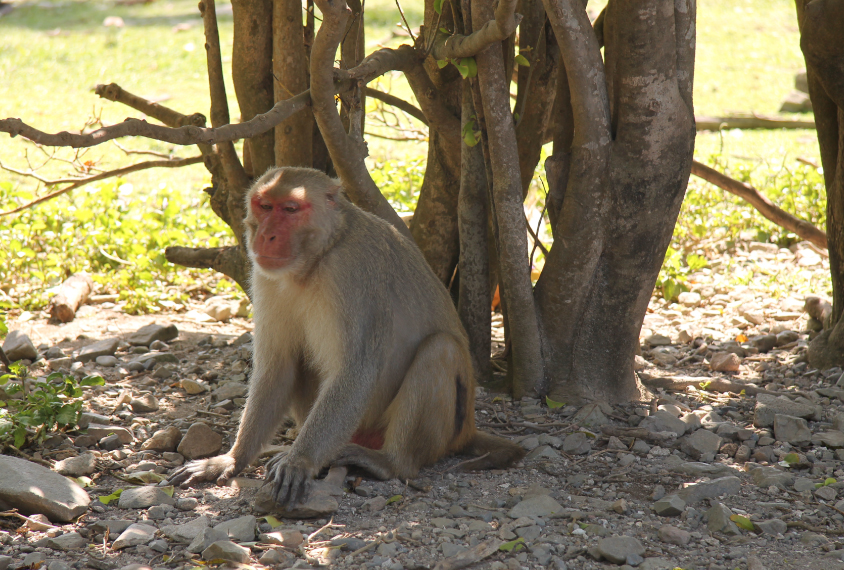
Friend me: Some monkeys, like 41N here, follow unusual social patterns — and carry a gene variant linked to autism.
All photographs by Brendan Borrell.
In 2007, Platt launched a wide-ranging research effort here to elucidate the role that genes and the environment play in shaping these animals’ social lives. Over the next five years, he hopes to bring monkeys with natural or engineered genetic variants into the laboratory, probing their atypical brains and testing drugs in experiments that would be impossible to conduct with people.
A decade ago, few in the research community would have anticipated that some of the most intriguing advances in understanding autism might come from feral monkeys on a Caribbean island. Monkeys are not the most convenient research animals: They are expensive to raise and take a long time to study. Many consider it unethical to conduct research — invasive or not — on primates. The result has been that most autism research is conducted using rodents as models.
But Platt and other researchers have begun to draw attention to the limitations that come with that mouse-sized package, namely that rodent brains are different from our own. Mice don’t form societies, and the critical bond between mother and child concludes at weaning. These differences may explain why the majority of clinical trials for neurological drugs based on mouse studies have failed.
Platt’s work has focused on the descendants of wild macaques on Cayo Santiago and in his Philadelphia lab, but he also has plans to study transgenic macaques in China whose genomes have been modified with a man-made mutation in SHANK3 along with the top autism gene, CHD8. A handful of other such transgenic monkeys have recently been engineered for autism research, promising insight into genetic influences on brain development and, potentially, a new platform for testing drugs that influence social behavior. “Mice are great for a lot of things,” Platt says, “but to study social behavior, you really have to study primates.”
“Are those autistic monkeys? I don’t know.” Michael Platt
Mighty mouse:
From the earliest days of medical science, rats and mice have been the top testing ground for lifesaving vaccines and treatments. Mice are easy to care for and mature in just six to eight weeks.
But 75 million years of evolution separate the house mouse, Mus musculus, from people. Researchers can alter the mouse genome to recreate some of the features of a human genetic disease by knocking out a healthy gene or slotting in a defective one, but for conditions such as autism, which are caused by many genes, it’s not so simple.
In people, autism diagnoses are based on interviews and observations, which can reveal whether someone avoids looking into other people’s eyes or following their gaze. But how exactly do you diagnose a mouse? Researchers videotape animals placed together in cages and score their social interactions, such as how often they sniff each other, and how often they show repetitive behaviors, such as grooming obsessively or running in circles. To test a mouse’s social interest, researchers might score how much time it spends with another mouse versus a wire cup.
But there can be many reasons why one mouse, say, sniffs less than another, including the possibility that it is simply less active. The upshot is that it’s just too difficult to know what a mouse is thinking, says Karen Parker, who studies primates and humans at Stanford University’s Autism Center in California. “I’d be hard-pressed to measure theory of mind in mice.”
Even mouse models of the most promising autism gene candidates have shown inconsistent responses in social assays. Since 2012, PsychoGenics, a company based in Tarrytown, New York, has tested five of the top mouse models using a battery of standardized behavioral tests. The only mouse that has shown a noticeable problem in sociality is a mouse lacking a large chunk of SHANK3, and even that difference is not statistically significant compared with social behavior in typical mice. “Studying social behavior in a mouse is a very difficult task,” says the leader of this effort, behavioral scientist Dani Brunner.
Funky monkeys:
Michael Platt never planned to study autism; he was just a boy who loved monkeys. “Every time I did a school project, it was about evolution,” he says. It was an obsession that wasn’t necessarily encouraged in the working-class Catholic neighborhood just outside of Cleveland where he grew up. Platt was the captain of his high school football team and in 1985 was recruited to play for Yale University. When he arrived, however, he quickly realized he didn’t want to be a jock. He took a course in primate evolution and soon got hooked, sorting through monkey bones in the drawers of the university’s Peabody Museum of Natural History.
After his third year at Yale, Platt spent three weeks in a summer field course on Totogochillo Island in Mexico’s Lake Catemaco, which hosted an introduced colony of stumptail macaques. The experience gave him an appreciation of the richness of the social lives of monkeys. It was also where met his future wife, Elizabeth Brannon, whose work now focuses on the behavior of human infants. While in graduate school, Platt tried to study wild wedge-capped capuchin monkeys in the seasonally flooded forests of Venezuela. It rained so much there that the trails disappeared under three feet of water teeming with anacondas, and the forest was so leafy he could hardly see the treetops where the monkeys were. One day in July 1991, he shot a pregnant monkey with a tranquilizer dart, aiming to catch her on a sheet. But he lost track of her in the canopy, and she crashed to the ground. She survived but the fetus did not.
Devastated, Platt fled from field work. He joined Paul Glimcher’s lab at New York University as a postdoctoral fellow, learning to record the activity of neurons in monkey brains in order to better understand how monkeys make decisions about what to look at. Platt was probing a murky region of the brain that sits between the visual and motor areas of the parietal lobe. He found that neurons in this region, called the lateral intraparietal area, fire more frequently when the monkey expects either a reward or a high probability of receiving the reward. His 1999 paper on this finding launched a new paradigm called neuroeconomics, which marries economic theory to the study of brain activity.
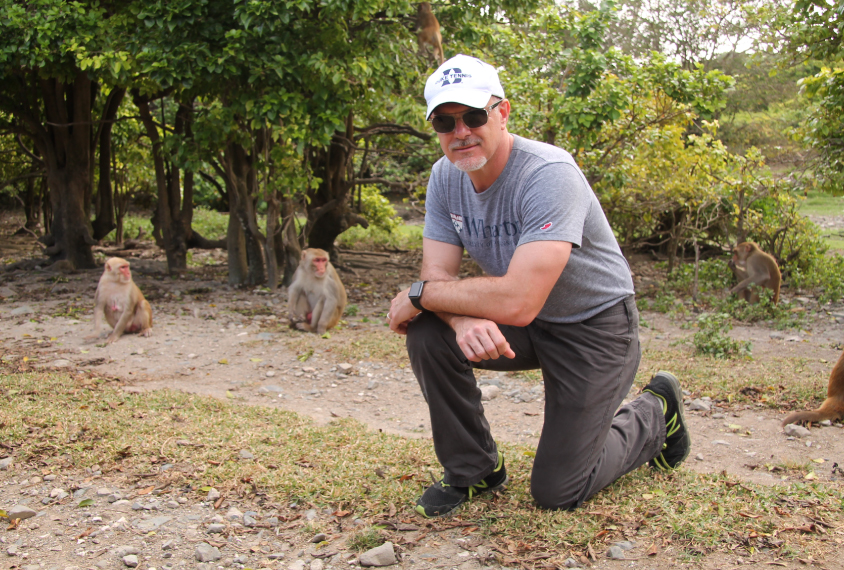
Monkey business: For neurobiologist Michael Platt, macaques offer many clues into social behavior in autism.
Platt took this nuts-and-bolts approach with him when he joined the faculty of Duke University in Durham, North Carolina. His goal then was to unlock the neurobiology underlying the social behavior of a dozen macaques he kept in the lab. Whom we look at — and who watches us looking — is a fundamental part of human relationships. During a conversation, when one person looks to the left, the other person reflexively follows the gaze. The reflex develops in early infancy, setting the stage for our complex social lives. Platt knew that primates, including macaques and chimpanzees, also seem to develop this behavior, but children with autism often do not. (Unlike mice, dogs and some birds also pay attention to the human gaze.)
In an early study, Platt and a postdoc in his lab, Robert Deaner, tracked how long it took people and monkeys to move their eyes to a yellow target that randomly appeared on the left or right side of a screen. Before the target flashed, an image of a monkey face would appear, gazing to either the left or the right. People and monkeys both shift their gaze more quickly in the correct direction when the image of the monkey face is also looking in that direction. Platt also recorded involuntary eye movements called microsaccades that are thought to indicate a shift in attention and expectations. The data from people and monkeys were almost identical, suggesting to Platt that both species process gaze the same way.
Platt grew convinced that monkeys, with their stripped-down cultures and customs, hold the key to cracking open fundamental questions about how our social brains develop — and, potentially, what happens when this typical development goes awry. In an experiment published in 2005 that he called “Monkeys Pay Per View,” he found that male monkeys were willing to forgo a juice reward to look at a photo of a high-ranking male or a female’s rear end (the equivalent of monkey smut). But he had to bribe them with an extra squirt of juice to get them to look at the lowliest members of their group. He later monitored which neurons were firing and found that the lateral intraparietal area is also involved in keeping tabs on the social hierarchy.
Soon, parents of children with autism began showing up at his talks and asking him the kind of question he was never trained to answer as a scientist: “What does this mean for us?” The pressure made Platt think about how to make his experiments more relevant to people, he says. “It was the first time I began thinking more seriously about the clinical implications of my work.” One of the people who witnessed this transformation was Geraldine Dawson, former chief science officer for the research and advocacy group Autism Speaks, which began to fund his research. “Michael’s interest in autism went from being strictly scientific to one that moved him emotionally,” she says.
When Platt was up for tenure at Duke, his department chair encouraged him to switch his focus to mice in order to take advantage of new genetic tools. Platt ran a study of decision-making in mice, but his heart wasn’t in it, and he never published the results. “I had no feeling for that organism at all,” he says. He was convinced that monkeys could provide answers mice never could. But he couldn’t keep more than two monkeys in a single cage at his lab — severely limiting his ability to study how monkeys socialize.
His best bet was to return to the field.
“Mice are great for a lot of things, but to study social behavior, you really have to study primates.” Michael Platt
Monkey Island:
The story of how Cayo Santiago came to be sounds like the plot of a science-fiction film. In the late 1930s, India was tightening restrictions on the export of its rhesus macaques for lab research. With the threat of World War II looming, scientists in the United States were concerned that their monkey supply would be cut off. Columbia University negotiated the purchase of Cayo Santiago and dispatched Clarence Ray Carpenter, a dashing young primatologist, to obtain macaques for the new colony. Carpenter’s benefactors had hoped to study tropical diseases, but he always envisioned the island as a natural laboratory for studying social behavior.
The expedition to India, Carpenter later recalled in an address to the University of Puerto Rico, was a “nervy business.” He had to negotiate with animal traffickers in Calcutta and bribe a ship captain to accept his cargo. He accompanied 500 monkeys back to New York and then on to Puerto Rico aboard the steamship S.S. Coamo. “I worked 14 or 15 hours a day,” he said. “I cleaned cages or fed animals all day long, exhausted, in rough weather or calm, then I went to sleep.”
Carpenter released a total of 409 monkeys on the island in December 1938 and January 1939, and established six feeding stations to keep the animals spread out. One of the early caretakers on the island, Angel Figueroa, who is now 85, recalls cooking huge vats of root vegetables during the 1950s. It was never enough. “They were always hungry,” he says.
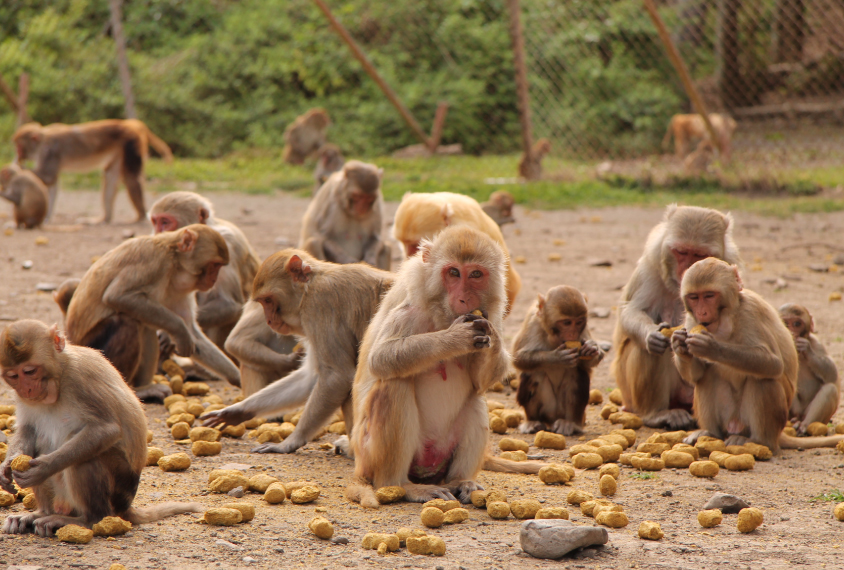
Rules of the game: The animals have six cliques, with pecking orders within each group.
When you set foot on Monkey Island even now, it’s hard not to feel like you’ve arrived on a Hollywood set. The island is just a five-minute boat ride from the mainland, but the perimeter is surrounded by ‘Do Not Enter’ signs that warn “Peligro, Estos monos muerden! Danger, these monkeys bite!” Before visiting, I had to sign a form acknowledging the risk of exposure to herpes B — a virus harmless to monkeys but potentially deadly to people.
From the dock, I follow Platt and colony manager Giselle Caraballo-Cruz through a dry stand of mangroves. Platt, a muscular man with a white goatee and a bald head, looks like a college coach heading out to practice. As we approach the island’s headquarters — basically a storage shed and picnic table surrounded by steel diamond mesh — a monkey scurries across the corrugated metal rooftop. Platt doesn’t bat an eye. He opens the door and invites me inside. “Out here,” he says, “the cages are for the people.”
The island is still strewn with the ruins of abandoned buildings, including stone shelters meant to give courting monkeys privacy, and an old cabin where the first manager and his wife lived. Today, no one sleeps on the island, and the monkeys have sex wherever they like. Researchers and caretakers come almost every day. They know the relationships of every monkey on the island and pedigrees dating back to the 1950s.
Owned and managed by the University of Puerto Rico, the island supplies some monkeys for medical research, but it is primarily a semi-wild laboratory where social interactions have consequences. (It’s where E.O. Wilson developed his theory of sociobiology in the 1970s.) A veterinarian treats any injuries that occur during the annual census, when workers trap hundreds of monkeys, clip their ears and tattoo their chests with a three-digit code, and draw blood for genetic work. Young ones also get vaccinated for tetanus. Other than that, the monkeys are left to fend for themselves, and the results can be gruesome. One monkey on the island today had his nose ripped off in a fight, leaving a hole between his eyes.
Name game:
Platt and I hike to the highest point of the island, a rocky summit known as El Morillo, and greet one of his graduate students, Sam Larson. Larson is standing inside a chain-link-fenced hexagon the size of a baseball diamond. Around him, two dozen macaques hunched on the ground meticulously sort through soap-sized bars of food, as though one piece of this commercial chow were measurably superior to another. Larson has just finished testing his new assistant on his ability to identify more than 200 individual monkeys by sight. “He passed,” Larson says.
Larson himself got a handle on the monumental task by naming them after characters in the television series “Game of Thrones.” The monkey Tyrion has a scar running across his face, while Jaime has a short, deformed arm. “Everyone else just calls him ‘Chicken Wing,’” Larson says. Monkeys are not just notable for their physical attributes. An old male who regurgitates his food into his cheek pouches and swallows it again is universally known as The Great Disgusto.
In addition to giving them all names, the researchers keep track of their social lives. All six groups are led by powerful females and their daughters and sisters. The largest and most dominant by far is Group F, with more than 300 members. When other monkeys see them coming, they get out of the way — fast. The members of group S are known as the hippies, because they tend to be more relaxed around people than the other groups are. Then there’s the V group, made up of what Caraballo-Cruz calls the “trash-can monkeys,” who don’t seem to fit in anywhere else.
Because this is a rare chance for Platt to see his study subjects firsthand, he asks the team about some of the monkeys with unusual behaviors. Caraballo-Cruz mentions 13H, who had plucked two perfect lines of fur from the base of her child’s tail. Over-grooming seems to run in the family.
“That’s really interesting, because the SHANK3 variant in mice leads to over-grooming,” he says, tapping out a note for himself on his smartphone. Platt doesn’t know if 13H has the SHANK3 variant, but he says the team needs to keep better track of aberrant grooming behaviors to hunt for genetic correlates.
Whereas Platt’s laboratory work gets its power from doing technically difficult studies with a handful of monkeys, his work on the island is based on collecting simple pieces of information from hundreds of them. In the summer, the island can be packed with up to 10 of Platt’s students, postdocs and collaborators. Even during the academic year, several assistants stay in Puerto Rico to observe the monkeys.
Each morning, they draw up a ‘hit list’ of individual monkeys to watch during a 10-minute block. Then they head out to the field with a handheld computer to record those animals’ social interactions, such as whom they spend time with, whom they groom and whom they threaten. Over time, these data have allowed Platt to map out the social networks and dominance hierarchies on the island, along with behavioral characteristics of individual monkeys.
In 2013, Lauren Brent, Platt’s former postdoc and field research guru who is now at the University of Exeter in the United Kingdom, reported that a monkey’s social tendencies can be passed down from parent to child. She used techniques developed in human behavioral genetics to collect data suggesting that monkeys with few grooming buddies tend to have specific variants of two genes that govern serotonin levels in the brain. One these genes, TPH2, has been implicated in depression and autism. The more recent discovery of a natural SHANK3 variant is particularly intriguing, because it shows that even the most complex and subtle social behaviors can have a clear genetic signature.
Platt and his colleagues have presented the SHANK3 findings at scientific meetings as a demonstration of the promise of the Cayo Santiago monkeys, but they say it’s too early to draw solid conclusions from the work. Rather than singling out one gene at a time, their goal is to conduct a genome-wide analysis of autism-related genes and their impact on monkey social behavior. They have sequenced the whole genomes of 220 monkeys and plan to add another 200 in the near future.
In a paper published in May, they described how the gaze-following reflex develops in 481 macaques on the island. The study, led by Alexandra Rosati of Harvard University, found that gaze-following begins to emerge at 5 months — the equivalent of an 18-month-old human infant — and declines with old age. Following puberty, females seem to follow gazes more than males, which aligns with patterns seen in people.
But these observations are only true of typical monkeys. It turns out that about one in every three monkeys at 1 year of age don’t follow gazes at all. “That’s what I’m most interested in,” Platt says. His goal now, he says, is to hunt for connections between gaze-following and genetic variants that might be relevant for understanding conditions ranging from social anxiety and schizophrenia to autism.
Model collaborators:
In 2013, as Platt’s team was busy collecting field data in Puerto Rico, a monkey unlike any other was born in a laboratory in the southern Chinese city of Kunming. An independent team of researchers there had inserted a mutated gene, MeCP2, into the one-celled zygotes of rhesus macaques and crab-eating macaques, another southeast Asian primate. Mutations in this gene cause most cases of Rett syndrome, which has similarities to autism and can be difficult to study in rodents. Mice with mutations in MeCP2 are anxious and eventually develop seizures, but they don’t look much like people with the syndrome.
One female macaque was born 162 days later, becoming the first-ever transgenic monkey model for autism, but the researchers haven’t described its behavior. In February, a second group of Chinese researchers used a different technique to create macaques with multiple copies of the human MeCP2 gene. MeCP2 duplication syndrome, like Rett syndrome, shares fundamental features with autism. The researchers have reported that the mutant monkeys pace in circles and let out anxious grunts. They also seem to be less social than controls: In a rudimentary behavioral test, the researchers found that the transgenic animals spend less time with other monkeys than controls do.
These tools are part of a resurgence in interest in monkey models, particularly as the gene-editing technique known as CRISPR has allowed quick and precise engineering. Guoping Feng, a neuroscientist at the Massachusetts Institute of Technology, has created a mouse in which SHANK3 has been rendered inoperative with a point mutation. He plans to insert the same mutation into the common marmoset, a palm-sized New World monkey with a white shock of fur around each ear. Marmosets weigh less than a pound and converse with each other using distinctive squeaks. “We say they are talking,” Feng says.
They are also fast breeders: Each pair produces twins or triplets twice a year. Over the past two years, Feng has bred a colony of 120 animals in Cambridge, Massachusetts. “We cannot say that the marmoset will be a better model than the mouse,” he says. “We don’t have proof of that yet, but based on the structure of their brains and their evolution, we think so.”
Platt’s group has also begun working with transgenic monkeys. In May, one of his graduate students visited the Chinese Academy of Sciences, where collaborators have engineered crab-eating macaques with a SHANK3 mutation and are making one with a mutation in CHD8, the top autism candidate gene.
Laboratory monkeys are also being recruited in basic research studies looking at how drugs may affect social behavior. Katalin Gothard, a researcher at the University of Tucson in Arizona, has identified neurons in the monkey amygdala — an emotional center of the brain —that respond specifically to eye contact. Gothard has shown that the strength of the gaze-following reflex in one monkey depends on the facial expressions of the monkey it is watching in a video. In a study submitted for publication, she found that giving male macaques oxytocin increases their likelihood of gaze-following. Gothard says oxytocin could ultimately help people with autism connect to their families and communities.
Platt has seen this struggle to connect firsthand as he has become more involved in the autism community. In November 2014, he visited the Marcus Autism Center in Atlanta, where he met children who had been placed in padded rooms and restrained in order to prevent them from punching themselves in the face. Platt says he hopes his work will directly improve the lives of people with autism, but Cayo Santiago has also given him a lens to think about the spectrum in the context of evolution.
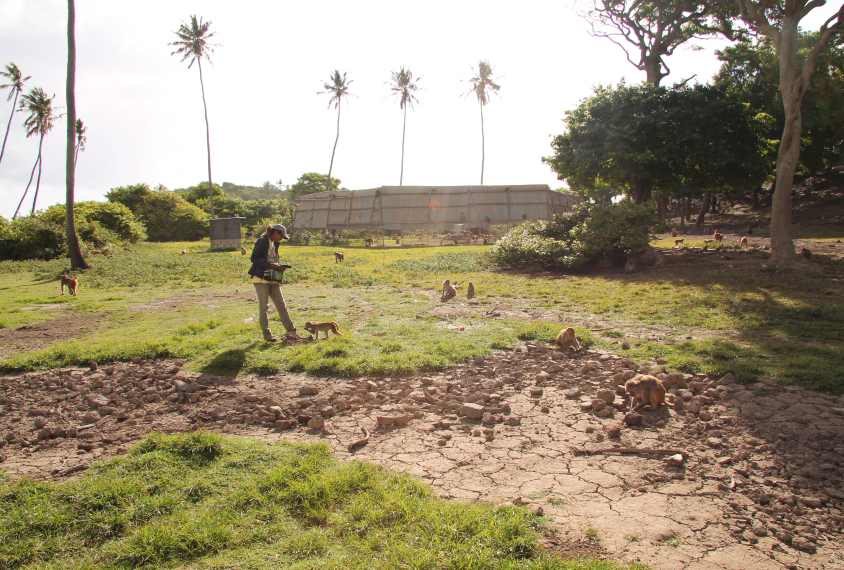
Social studies: More than 1,500 feral macaques roam Cayo Santiago, creating a natural lab for social behavior.
The close monitoring of monkey social life — Platt’s boyhood passion — continues to elicit deep questions. One of the most remarkable monkeys on the island is a male named Pinocchio, who sits near the bottom of the dominance hierarchy, ranked 39 out of 48 males in the powerful Group R. He was originally born into group F in 1999, but has bounced in and out of it twice over the past six years. Pinocchio is one of the floaters that have been observed since the island’s early days but never formally studied. Although Pinocchio has fathered a few children, he is no longer able to reproduce due to an injury, possibly from a fight. He spends a lot of his time alone, which is where we find him.
“Is living outside of groups adaptive?” Platt wonders. His research has been built on the idea that the failure to develop social behavior could be a pathology. But he says he can also see how living outside of the group has some advantages, particularly for a low-ranking male such as Pinocchio.
All that time alone over the years has given Pinocchio time to innovate: He is the only monkey on the island who knows how to open a coconut. When he finds one, he goes down to the concrete dock and tosses it up in the air again and again for hours until it finally breaks open. For this particular monkey, solitude holds sweet rewards.
By joining the discussion, you agree to our privacy policy.